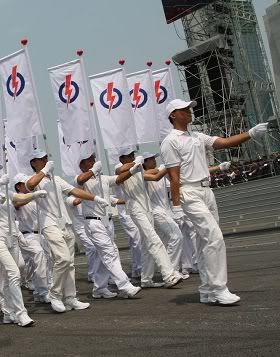Eugene Tan

Men In White
Election talk has been around for much of this year. Last Saturday, the signals got clearer when Prime Minister Lee Hsien Loong told the Singapore media in Hanoi, where he was attending the ASEAN Summit, that the Electoral Boundaries Review Committee (EBRC) had been convened.
In many respects, the announcement was long anticipated, given that there are only 12 months left to the current Parliament’s term. Further, the fourth Presidential Elections must be conducted by August 2011. Having the two elections close to each other can result in voter fatigue and may unnecessarily contribute to a prolonged politically-charged environment.
The General Election for Singapore’s 12th Parliament will see at least 12 single-member constituencies (SMCs), fewer six-member group representation constituencies (GRCs) and perhaps the reintroduction of four- or even three-member GRCs.
With the changes to the Parliamentary Elections Act, however many they actually win at the polls, the Opposition is guaranteed at least nine seats in the House, with any shortfall made up through the Non-Constituency MP scheme.
The standard terms of reference would require that the EBRC review the electoral division boundaries and recommend changes to them. Typically, the EBRC will focus on population changes within existing boundaries in the context of larger demographic shifts across the island. In essence, the EBRC’s general mandate is to provide for fair and balanced representation through adjusting electoral boundaries by avoiding an uneven distribution of voters.
Given the increase in the number of eligible voters, and assuming that the current MP-to-voter guide ratio of one to 26,000 is maintained, the EBRC may recommend an increase in the number of elected MPs, currently 84.
In reviewing electoral boundaries, the EBRC operates on a 30-per-cent deviation rule. Let’s assume the ratio of one MP serving 26,000 voters is maintained; the number of voters in an electoral division can range from 18,200 to 33,800 (30 per cent plus/minus of 26,000). Extrapolating from this, a five-member GRC can have between 91,000 and 169,000 voters – the difference between the minimum and maximum number of voters being a whopping 86 per cent!
This affects the principle of fair and balanced representation and results in different “workloads” for MPs. This also has implications for the equality of votes. A voter in a five-member GRC with 91,000 voters has effectively more voting power since it returns as many MPs as another five-member GRC with 170,000 voters.
Take the case of the May 2006 elections. The five-member Aljunied GRC had 145,141 voters, while six-member Tanjong Pagar GRC had only 3,000 more voters. Potong Pasir, the smallest SMC, had just 15,888 voters while the largest SMC, Bukit Panjang, had 30,452 voters.
In my view, the 30-per-cent deviation rule is too high. In contrast, the United Kingdom is working towards a 5-per-cent deviation, like New Zealand. Australia operates on a 10-per-cent deviation.
If relatively larger countries with more uneven spreads of population can do with 5- to 10-per-cent deviation, our 30-per-cent deviation seems “overly-generous” in small and compact Singapore.
Clearer Justifications
Of course, a larger deviation rule also means a higher tolerance for the size of an electoral division, which would mean, theoretically, less need to redraw any boundaries.
The committee’s work of redrawing the boundaries should studiously avoid any hint of gerrymandering. The odd-shaped electoral boundaries that we have also erode the voter sense of identity and belonging to his constituency. A commonly cited example is that of Braddell Heights being part of Marine Parade GRC, never mind the fact that MacRitchie Reservoir is closer to the estate than East Coast Park!
The EBRC has to respond to the legitimate expectations of a more educated electorate sensitive to fair play. The EBRC’s recent reports were generally quite sparse in terms of detailing its thought process and reasoning. They need to be more substantive and better articulate the reasoning and justification for their recommendations. This is one area where there can be lots of improvement.
Voters are entitled to know why boundaries are drawn, and how they are done. Otherwise, it should not be surprising if Singaporeans view the redrawing of boundaries as being calculated to undermine the Opposition or, at the very least, not disadvantage the ruling party.
Ultimately, the EBRC’s work and report must not only be non-partisan but must be seen to be non-partisan, as well. This is necessary to sustain confidence and legitimacy in the review of electoral boundaries, since that is an integral part of the electoral process.
Put simply, the process by which electoral boundaries are reviewed is just as important as the specific changes that flow from the review. This is notwithstanding the reality that the redrawing of electoral boundaries is perceived to be inherently political, and that it is probably impossible to have perfectly distributed electoral divisions.
For now, political parties and voters will wait with bated breath for the EBRC’s report.
—
Eugene Tan is an assistant professor at the School of Law, Singapore Management University. This article was first published on 1 November 2010 on TODAYonline


“This affects the principle of fair and balanced representation and results in different “workloads” for MPs. This also has implications for the equality of votes.”
What is the implication of some ministers holding multiple portfolios (e.g. current Home Affairs Cum Law Minister) while others having no portfolios? I hope at least it has some implications when it comes to computing annual bonuses.